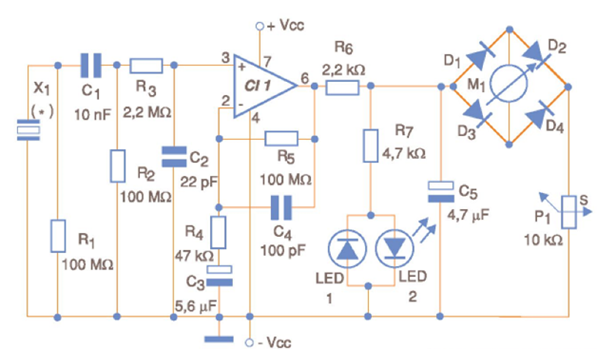The circuit illustrated in the figure can be used to detect earthquakes or vibrations of foundations and the ground itself during the operation of heavy industrial machinery and equipment. An important application would be in assessing the degree of vibrations transmitted by misadjusted or poorly fixed machinery that could cause long-term damage to the structure of the buildings in which they operate. The sensor in this circuit is a piezoelectric ceramic taken from a gas stove lighter. This ceramic must be positioned in such a way that vibrations in the vertical direction activate it, and a weight must be placed on it that will act as a pressure mass generating the signal for the circuit. The very high-gain operational amplifier, as well as the components that polarize it, must be mounted in a shielded box to avoid noise pickup, since the circuit is extremely sensitive. The gain is provided by a 100 M ohm resistor in the feedback, and the capacitor in this same circuit in series with the resistor connected to the (-) pin of the operational amplifier determines its frequency response for the very low range (infrasound), in which most of the signals that must be detected are concentrated.
The instrument is a common microammeter with 1 or 2 mA full scale. For best performance, the diodes connected to the tip that activates this instrument must have a low conduction voltage, such as germanium types. If possible, Schottky diodes would be even better. The circuit also has two indicator LEDs, and its power supply must be provided by a symmetrical source. We also have the possibility of applying the detected signals to an external recorder, including an analog-to-digital converter (ADC) for recording on a computer. The circuit consumption is low, and it can be powered by batteries. Equivalent operational amplifiers such as the CA3140 can be tested in this circuit.




